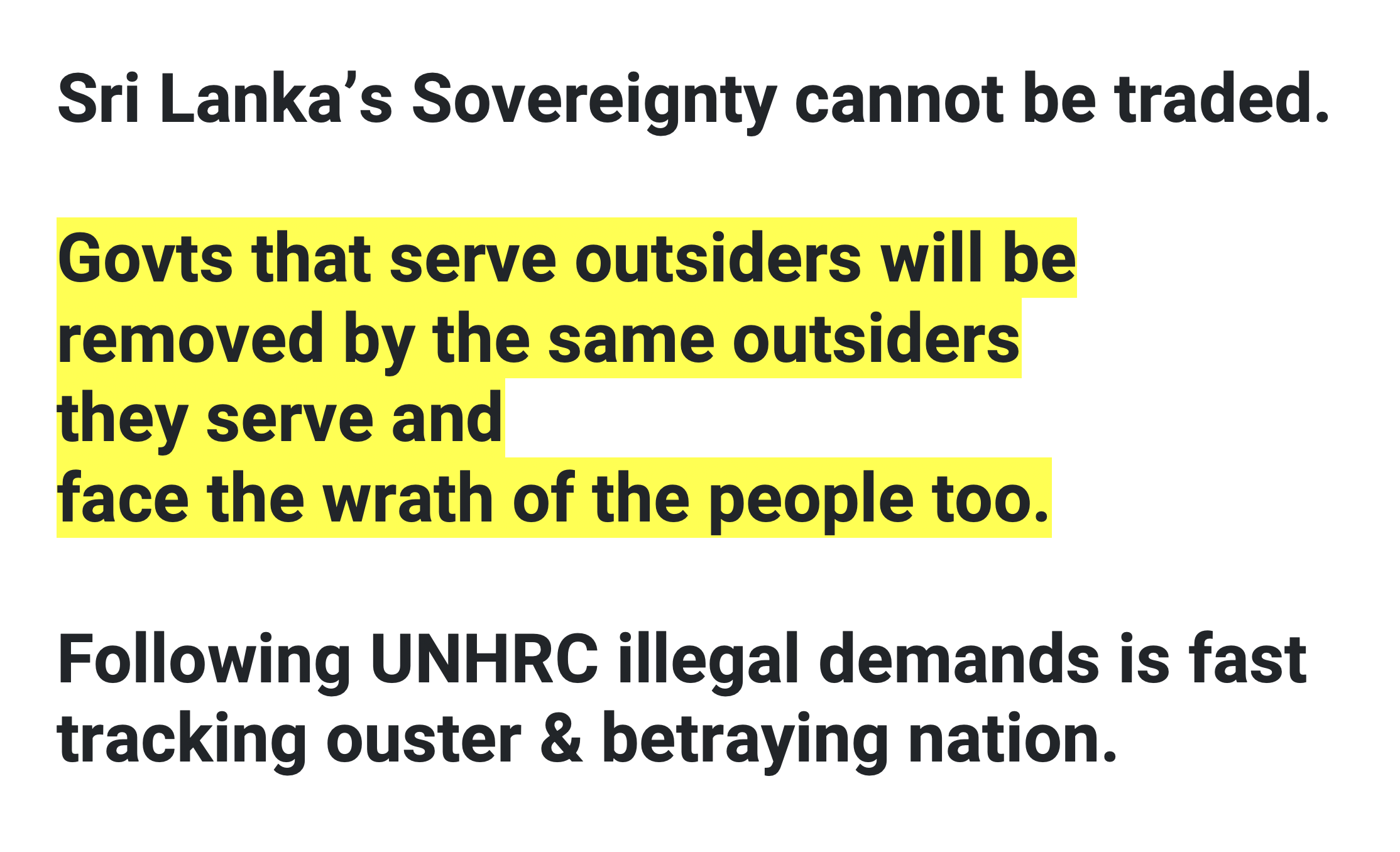Sri Lanka Land releases after 2009 – State Land, Private Land & “No Military Land”

Since the defeat of the LTTE in May 2009, Sri Lanka has faced continuous demands—mainly from international actors, NGOs, and local separatist lobbies—for the return of lands in the North and East said to be “occupied” by the military. Much of the narrative has been driven by propaganda and not fact. Even UNHRC reports are referring to “military lands”. There is no such lands. The military was primarily stationed on State land, with only a handful of private lands temporarily used for operational purposes, which were verified and returned to their rightful owners—contrary to claims that large tracts of private land remain under military control. Any remaining contentions regarding private land arise solely from claimants who cannot provide verifiable title deeds, Survey Department records, or legal documentation; Sri Lankan law requires such proof before land can be returned. It is therefore essential to separate reality from rhetoric.
There are three types of land at issue:
- Private Land– belonging to individuals or institutions with legal title deeds.
- State Land– owned by the Republic and managed by Government on behalf of the People (about 82% of Sri Lanka’s land is State-owned).
- No “Military Land”/ No “Civilian land”– a term invented by external actors. In law, it does not exist. The armed forces, as a permanent state institution, have a constitutional right to be stationed anywhere in the country, including on state land.
The term “military land” appears only in UN and NGO reports—it does not exist in Sri Lankan law. The Constitution and the State Lands Ordinance make no such distinction.
By law, State land is vested in the Republic (Article 33 and Article 99 of the Constitution, State Lands Ordinance). Successive governments are only temporary custodians; they cannot permanently alienate such land without public purpose.
Any conversion of State land into private ownership without proper procedure is unlawful.
State land is the collective property of ALL Sri Lankans (this generation & future generations), not only one ethnic community for this generation & for their next generations.
LTTE occupation ignored by the UNHRC
In late 1980s/early 1990s, the LTTE forcibly displaced Sinhalese and Muslims from Northern districts and illegally occupied their private lands/properties and state lands. These lands are rarely discussed in Geneva.
Why is the UNHRC silent on:
- The restoration of lands seized by the LTTE?
- The property rights of Sinhalese and Muslims who lived in the North since independence?
- The illegal conversions of land that took place during LTTE occupation?
This one-sided focus undermines the credibility of UNHRC allegations.
UNHRC Allegations vs. Facts
UNHRC Claim: “Military occupation of land prevents resettlement.”
Fact: By 2017, 70% of released land was State land, not private.
No citizen was intentionally deprived of ownership.
UNHRC Claim: “Tamil civilians cannot access their ancestral lands.”
Fact: Ownership requires title deeds under Sri Lankan law (and Thesavalamai in Jaffna). Mere claims or placards are not proof. Verified private land has already been released.
UNHRC Claim: “Military bases are maintained on civilian lands.”
Fact: There is no legal category of “civilian land.”
There is Private land (returned upon verification) and State land (where the Army has every right to remain).
UNHRC Claim: “Demographic changes are being engineered.”
Fact: There is no evidence of state-led demographic change.
The real demographic shift occurred when the LTTE ethnically cleansed Sinhalese and Muslims from the North, which the UNHRC ignores.
LLRC on Land Issues
The Lessons Learnt and Reconciliation Commission (2010–2011) found that:
- Land disputes were aggravated by conflict and LTTE occupation.
- LTTE forcibly displaced communities and illegally occupied both State and Private land.
- Many disputes arose due to tampered deeds and lack of documentation.
- Testimonial deeds are not valid for ownership.
- The State has authority over State land, while verified Private land must be respected.
- The Army should release verified Private land not needed for security, but this doesnot apply to State land.
Land Releases since 2009 (State vs Private)
Successive governments have released thousands of acres since 2009.
These are presented as “military-occupied lands returned to the people.” This is factually incorrect.
But the breakdown shows a different reality:
As of May 2017:
- State land released: ~54,769 acres
- Private land released: ~24,394 acres
- Ratio:69% State vs 31% Private
By Dec 2018:
The Army reported 69,754 acres released (mix of State & Private) out of 84,523 acres used.
Illustrative releases:
- 454 acres (Private) – Thelippalai/Palaly (2016)
- ~63,000 acres (Govt + Private) – by Mar 2024
- 7 acres (Private) – Jaffna, May 2025 (Army official report)
By 2017, almost 70% of all land released was State land—proving that private citizens were not deprived.
Yet international reports continue to frame this as private dispossession.
The Core Issues:
- No “Military Land”:No “Civilian Land”. A propaganda term without legal basis.
- Private Land:Already released upon verification of deeds,
- State Land:Belongs to the Republic. The Army has every right to remain. Any release is a political choice, not a legal obligation.
- Ignored Questions:Why is the UNHRC silent on LTTE land seizures, displacement of non-Tamils, and the legal procedures required for private restitution?
Why does the UNHRC ignore LTTE’s occupation of land and displacement of non-Tamils?
- Why has the UNHRC ignored LTTE occupation of land (both State and Private) and the displacement of Sinhalese and Muslims?
- Why does the UNHRC repeatedly refer to “military land,” “Civilian land” terms that does not exist in Sri Lankan law?
- Why does the UNHRC not acknowledge that themajority of land released was State land—showing the Army was never depriving private owners of their property?
- Why is the UNHRC silent on the legal requirement of verifying ownership (title deeds, surveys, inheritance under Thesavalamai) before private land can be restored?
Why was State Land Released?
This is the central issue.
State lands belong to the Republic—not to any temporary government.
Governments are only custodians.
Governments cannot cede or convert State land into private property arbitrarily.
Yet, under international pressure and NGO propaganda, successive governments released State lands unnecessarily—lands which should have been kept for security, development, or future generations.
This raises key questions:
- Who benefited from these land releases?
- Who are occupying State land claiming these to be “private”
- Why was land belonging to all Sri Lankans ceded disproportionately to one community?
- Should not State land remain available for all citizens, not privatized under pressure?
Any State land transferred into Private Land is ILLEGAL and steps must be taken to RETURN this land back to the State.
The Way Forward
- Private land– must be returned only to verified owners through a transparent process.
- State land– must remain with the State. The Army can be stationed anywhere lawfully.
- “Military land”– does not exist. Using the term delegitimizes the armed forces.
The land debate has been clouded by propaganda. Sri Lanka must clearly assert that:
- State land belongs to the Republic, not any community.
- Verified private land has already been returned.
- “Military land” “Civilian land” is a myth invented to discredit the armed forces.
The UNHRC cannot demand that Sri Lanka cede State lands under the guise of “occupation.” The real question is: who gained from the release of State lands that rightfully belonged to the Republic and where the Army had every right to remain?
Shenali D Waduge







